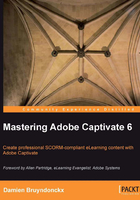
Summary
In this second chapter, we have completed the first step of the Captivate production process: capturing the slides. Throughout this chapter, our main concern was to manage the size of the project as compared to the size of the application to capture.
Several approaches are possible to address this sizing issue. While experiencing each of these approaches we uncovered two important features of Captivate: Full Motion Recording and Panning.
Shooting a Captivate movie is a four-step process. First we have to prepare the application to shoot and reset our system to default. Then, we rehearse the script as many times as needed to fully master all the actions. The third step is to shoot the movie, and the last one is to preview the rushes. If you decide that the rushes are not good enough, just start over until you get it right. Remember that the success of the editing phase that follows depends on the quality of the shooting
We also discovered that Captivate has four automatic recording modes that are Demonstration, Assessment Simulation, Training Simulation, and a Custom mode that is ours to create. Each of these automatic recording modes adds Text Captions and other objects to our slides.
Captivate 6 also introduces the Video Demo project type. A Video Demo is like a big Full Motion Recording. It is used to create a .mp4 video file that can be easily uploaded to an online video hosting service such as YouTube, Vimeo, DailyMotion, or else.
Of course, we are far away from the final result we want to achieve, but that was not our goal anyway. The project now has to go through the editing phase to reach its final aspect.
To wrap up this chapter, these are some tips and tricks for successful recordings:
- Use the automatic recording modes whenever possible.
- If you have to shoot full screen, reset your desktop to its default appearance, that is: remove your custom wallpaper, turn off any custom color scheme, or mouse-pointers-sets. Your computer should look like any computer.
- Turn off your screen saver.
- Turn on the sound, so you can hear the camera shutter and the keystrokes. This will help you have a better control over the recording process.
- If you are not sure whether or not Captivate took a given screenshot, don't hesitate to take one manually by using the Print Screen key (Windows) or the cmd + Fn + F6 shortcut (Mac OS). During the editing phase that follows, it is much easier to delete an extra slide than to generate a missing slide.
- Perform the actions slowly, especially the text typing actions and the actions that require a Full Motion Recording. You'll be able to set up the timing of each slide with great precision during the editing phase.
- Rehearse your scripts before shooting.
With these tips and tricks and a bit of practice, you'll soon be producing high quality eLearning content!
In the next chapter, we will begin the editing phase of our work. The editing phase is the most time-consuming phase of the entire process. There are so many options and tools to discover that one chapter will not be enough to cover it all. Consequently, the editing phase will span in the few upcoming chapters.
In the next chapter, we will cover Text Captions, Mouse movements, Highlight Boxes, Images, Zoom Areas, and their formatting options. We will also use the Timeline to arrange our objects in time and the alignment toolbar to arrange our objects in space.